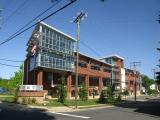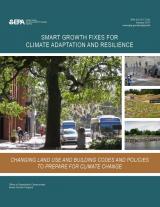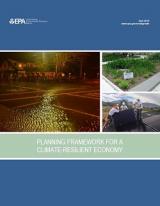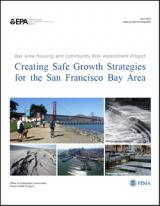Smart Growth and Climate Change
Background
This page deals with climate change as it relates to land use and development. If you are looking for information about climate change generally, please use the search box at the top of this page to search for information across EPA's website.
Smart growth policies contribute to both mitigating and adapting to climate change. Mitigation strategies reduce greenhouse gas emissions from development, and adaptation strategies make communities more resilient to the effects of a changing climate. Smart growth strategies also bring environmental benefits and provide economic advantages to local governments and the private sector. In addition, they can save people money on energy and transportation, which is particularly important for low-income residents, and help protect human health.
Mitigation
The way we develop our communities has significant impacts on greenhouse gas emissions. Communities can reduce greenhouse gas emissions from development and redevelopment if they:
- Build compactly and use energy-efficient, green building techniques, which reduce emissions from both electricity generation and transportation.
- Growing Cooler (PDF), Exit a 2008 study published by the Urban Land Institute and partially funded by EPA, concluded that compact development can reduce vehicle miles traveled by 20 to 40 percent compared to conventional development. Based on the amount of development that will take place and the percentage of that development that could reasonably be expected to be compact infill, the study estimated that compact development could reduce carbon dioxide (CO2) emissions by 7 to 10 percent in 2050.
- A subsequent study, Moving Cooler, Exit found that a combination of more compact development and investments in transit and other transportation options could reduce greenhouse gas emissions from transportation by 9 to 15 percent by 2050.
- Reuse existing infrastructure and buildings to take advantage of previous investments and the energy already used to build them.
- Put homes, jobs, stores, parks, schools, and other destinations close to each other so that people can easily walk, bike, use public transit, or drive shorter distances.
- Preserve green space, which can sequester CO2, by conserving ecologically valuable land and promoting development in previously developed areas, which helps reduce pressure to build on undeveloped land.
Adaptation
We are already seeing the effects of climate change, and these effects are projected to become more pronounced in the coming decades. The 2018 National Climate Assessment notes some effects of climate change in regions around the United States. Depending on the region, effects could include more and stronger storms, more drought, more frequent extreme-heat events, rising sea levels, and more flooding. Knowing the changes projected for your region is essential to planning land use.
Smart growth strategies could help communities adapt to these changes, as well as natural disasters, economic changes like volatile energy prices, and other challenges that could arise regardless of climate change. Some strategies communities could consider include:
- Determine which areas are both well-connected to existing development and less vulnerable to current and projected climate change impacts such as wildfires, sea level rise and higher storm surges, and riverine flooding, and encourage growth in these areas.
- Discourage building in areas that are currently or are projected to be more vulnerable to climate change-related impacts. Making it easier to build in safer areas can help relieve pressure to develop in more vulnerable areas.
- Preserve large, contiguous areas of open space to better protect ecosystems that might be under pressure from the changing climate. Open space preserved along water bodies can also absorb flood waters and reduce flooding in developed areas.
- Coordinate land use and transportation infrastructure decisions, and incorporate climate change projections into these decisions.
- Encourage water- and energy-efficient buildings and land use patterns so that communities can continue to thrive if energy prices rise. This strategy can also help communities and their residents better cope with drought and extreme heat.
- Upgrade stormwater systems to better manage heavier storm flows, and consider using green infrastructure to reduce the amount of runoff from paved surfaces.
- Encourage green roofs, parks, street trees, and other elements that can reduce ambient air temperatures and filter pollutants from stormwater runoff and the air.
- Design buildings with adaptation and resilience in mind. For example:
- Modular buildings can more easily be moved, renovated, and deconstructed as a community or tenant’s needs change and as climate-related impacts change. Strategies include using exposed mechanical fasteners, disentangling utilities from the structure, using moveable walls and ramps, using standard-sized modular building components and assemblies, and providing easy-to-understand information on construction drawings and documents.
- Buildings designed for passive survivability – meaning they remain habitable if they lose external power for an extended period – can help ensure that even if the power goes out, the building will stay at a safe temperature. Because passive survivability techniques such as better insulation and operable windows often save energy as well, they can also save occupants money on energy bills.
EPA and Other Federal Resources
Web Resources
Smart Growth Strategies for Disaster Recovery and Resilience discusses EPA's work helping communities prepare for and rebuild after disasters. Much of this work is relevant to climate change adaptation, including projects on flood resilience and recovery in Vermont, preparing for sea level rise in coastal North Carolina, and climate change and resilience assistance to the state of Iowa.
EPA's Climate Change Adaptation Resource Center lets local government decision-makers create a package of information tailored to their needs. Users can find information about the risks posed by climate change to the issues they are concerned about, relevant adaptation strategies, case studies illustrating how other communities have adapted to those risks and tools to replicate their successes, online training, and EPA funding opportunities.
The U.S. Climate Resilience Toolkit provides tools, information, and expertise to help people manage climate-related risks and opportunities and improve resilience to extreme events.
EPA climate change research includes information about the science of climate change, health and environmental effects, U.S. climate policy, and climate economics.
EPA's portal for energy information links to information about energy and climate change, clean and renewable energy, energy efficiency, transportation's energy impacts, and ways to save energy.
Energy Resources for State, Local, and Tribal Governments provides technical assistance, analytical tools, and outreach support to state and local governments' climate and clean energy efforts.
The Heat Island Effect pages include information about heat islands and ways to mitigate the higher temperatures these urban and suburban areas can cause.
EPA's Green Infrastructure pages have tools, case studies, and other resources to promote green infrastructure solutions.
Publications and Webinars
Some of the materials below have been archived. To find them, click on the "Search EPA Archive" button behind the resource name and type or copy and paste the title of the resource into the search box on the EPA Archive home page.
Regional Resilience Toolkit: 5 Steps to Build Large-Scale Resilience to Natural Disasters (2019): Toolkit, created through a partnership among FEMA, EPA, and the Metropolitan Transportation Commission/Association of Bay Area Governments (MTC/ABAG), that helps regions plan for disasters by working across multiple jurisdictions and with nongovernmental partners.
Fourth National Climate Assessment (2018): Summarizes the impacts of climate change in different regions of the United States and on various sectors, including the built environment, urban systems, and cities.
Smart Growth Fixes for Climate Adaptation and Resilience: Changing Land Use and Building Codes and Policies to Prepare for Climate Change (2017): Guide that describes specific changes communities could make to their land use and building policies to prepare for climate change while gaining other environmental, economic, health, and social benefits in the short and long terms.
Planning Framework for a Climate-Resilient Economy (2016): Tool, developed through a technical assistance project with the Rhode Island Division of Planning, to help communities assess how climate change could affect their economy, improve their economic resilience, and think creatively about ways to prosper in a changing climate.
Energy Efficiency and Renewable Energy in Low-Income Communities: A Guide to EPA Programs (2016): Guide that helps state and local staff connect with EPA initiatives that can help them expand or develop their own energy efficiency, renewable energy, and climate change initiatives in ways that benefit low-income communities.
Tribal Green Building Toolkit (2015): Provides information on how tribes and other communities can prioritize and implement green building codes, policies, and practices. Includes sections on land use, energy efficiency and renewable energy, and resilience and adaptability.
Creating Safe Growth Strategies for the San Francisco Bay Area (2015): Report from a technical assistance project with the Association of Bay Area Governments to help incorporate resilience to natural hazards and climate change into regional and local land use planning, decision-making, and implementation.
District-Scale Energy Planning Search EPA Archive(2015): Report from a technical assistance project with San Francisco to explore how the city could encourage district-scale energy systems, which can reduce greenhouse gas emissions.
Enhancing Sustainable Communities With Green Infrastructure: A Guide to Help Communities Better Manage Stormwater While Achieving Other Environmental, Public Health, Social, and Economic Benefits (2014): Guide that describes how to develop a vision and plan that integrate green infrastructure and sustainable communities strategies for multiple benefits, including mitigating and adapting to climate change.
Our Built and Natural Environments: A Technical Review of the Interactions Between Land Use, Transportation, and Environmental Quality (2nd Edition) (2013): Comprehensive review of research on how development patterns affect the environment and human health. Chapter 3.6 looks at how development affects greenhouse gas emissions and global climate change, and Chapter 4 discusses how certain types of development patterns can reduce environmental and health impacts.
Using Smart Growth Strategies to Create More Resilient Communities in the Washington, D.C., Region Search EPA Archive (2013): Report from a technical assistance project with the Metropolitan Washington Council of Governments that gives local governments policy options to consider when preparing for climate risks while also meeting other environmental, economic, and social goals.
Iowa Climate Change Adaptation and Resilience Report Search EPA Archive (2011): Results from a project in which EPA and FEMA worked with state and local leaders in Iowa to figure out how the latest science on changing weather patterns due to climate change could be integrated into local and state planning efforts to adapt to and mitigate future natural disasters.
Location Efficiency and Housing Type – Boiling It Down to BTUs (2011): Jonathan Rose Companies for EPA. Examines how a home's location and access to transit affect a household's energy use, compared to using energy-efficiency measures in homes and cars.
Strategies for Sustainable Communities: A Guidebook Based on California Community Types (2010): Publication from a technical assistance project with the California Strategic Growth Council that offers smart growth strategies to reduce greenhouse gas emissions, indicators to track progress, and resources for 10 community types ranging from major cities to rural communities.
Local Climate and Energy Strategy Guide — Smart Growth (2010): Describes how smart growth strategies can help local governments reduce greenhouse gas emissions and improve quality of life.
Design for Deconstruction (2007): Provides information on designing buildings for adaptation and eventual deconstruction and reuse to support smart growth, disaster relief, and sustainable materials management.
Other Resources
The following links exit the site Exit
Websites
The Georgetown Climate Center includes climate change resources and research useful to states and communities, including resources on land use and the built environment.
The Lifecycle Building Challenge provides research and examples of designing buildings for climate adaptation.
Publications
"Chapter 12: Human Settlements, Infrastructure and Spatial Planning" of Climate Change 2014: Mitigation of Climate Change, the contribution of Working Group III to the Fifth Assessment Report of the Intergovernmental Panel on Climate Change, includes useful information about how different development patterns and transportation options affect greenhouse gas emissions. See the report's main page for the link to download Chapter 12 and other parts of the report.
Getting Smart About Climate Change, by ICMA and the Smart Growth Network (2010): This report, done under a cooperative agreement with EPA, outlines nine strategies for successfully applying smart growth principles to climate concerns on the local and regional levels.
Growing Cooler (PDF), by Reid Ewing, Keith Bartholomew, Steve Winkelman, Jerry Walters, and Don Chen (2008): Book published by the Urban Land Institute and partially funded by EPA that connects compact, walkable development with CO2 reductions.
Moving Cooler: An Analysis of Transportation Strategies for Reducing Greenhouse Gas Emissions, by Cambridge Systematics, Inc. (2009): Report cosponsored by EPA that examines the greenhouse gas reductions from and costs of almost 50 transportation strategies, individually and in various combinations, including smart growth strategies such as more efficient land use, better public transportation, and encouraging walking and biking.




